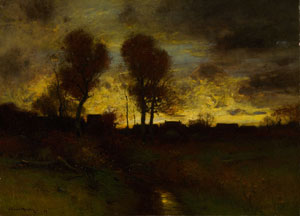
Afternoon Light, 1887
Oil on canvas
Collection of John and Elizabeth Driscoll
Because American Impressionism is so widely admired today, it is surprising to learn that it took a back seat, critically and commercially, to another movement. Lasting from the 1880s into the 1910s, Tonalism was hailed at the turn of the century as a truly American art, devoid of the French influences so apparent in the work of the American Impressionists. In truth, Tonalism also had French ancestry in the Barbizon School, but being "Americanized" by a previous generation of artists, the movement had become accepted and admired in the United States.
Central to forming and codifying the tenets of Tonalism was the artist George Inness. Initially associated with the Hudson River School, Inness had embraced the Barbizon aesthetic of the cultivated landscape early in his career. His experiments in the mid-1870s with suggestive landscapes became the virtual definition of the style and Inness, its creator, the magnet to a coterie of followers.
In formal terms, Tonalism was a rejection of the grandiose landscapes of the Hudson River School that had preceded it. Yet it was a continuation of America's love affair with the land. The Tonalist artists relied on abstraction through concentration on fragments of landscape that, while familiar, were never specifically identifiable. These anonymous landscapes, with nebulous titles linked to times of day or season, were meant to trigger the imagination of the viewer. Rich color and narrow gradations of tone in these canvases (resulting from the complex layering of thin oil glazes built up in many stages) imbued the works with a meditative spirituality.
In spite of its success, Tonalism's time in the spotlight was short. By 1905 it was being eclipsed by the American Impressionists as well as the gritty, urban aesthetic of the young painters of the Ashcan School. Ironically, the very aspects that had led to the success of the movement (nostalgic images looking back as if to some lost age) led to its demise. In spite of its visual poetry, Tonalism's countless repetition of variations on the same theme was not ultimately sustainable.


